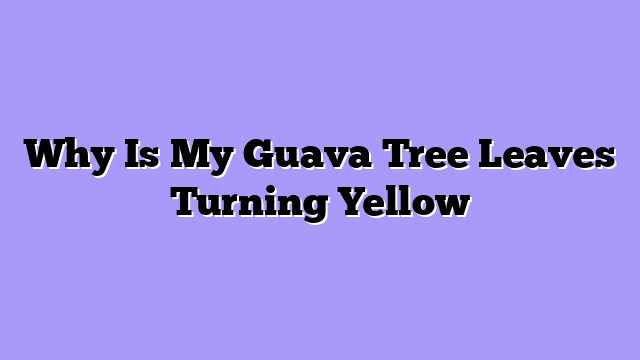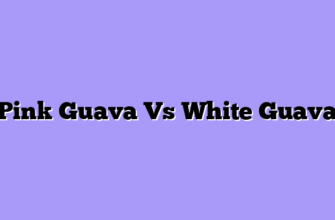The vibrant green foliage of a guava tree is a testament to its health and vitality. However, when the leaves begin to turn yellow, it can be a cause for concern. While there are various factors that can contribute to this discoloration, nutrient deficiencies are often the culprit. Understanding the specific nutrients that are lacking can help you address the issue effectively and restore your guava tree to its former glory.
Nutrient Deficiencies
- One of the most common nutrient deficiencies that leads to yellowing leaves is a lack of nitrogen. Nitrogen is essential for chlorophyll production, the pigment that gives plants their green color. When nitrogen levels are low, the leaves may exhibit a general yellowing, starting from the older leaves and progressing towards the newer ones. This is because the tree prioritizes nitrogen for its newest growth, leaving the older leaves to suffer.
- Another crucial nutrient for healthy guava trees is iron. Iron is involved in chlorophyll production and plays a vital role in photosynthesis. Iron deficiency, also known as chlorosis, can manifest as yellowing between the veins of the leaves, while the veins themselves remain green. This is because the iron is unable to move freely within the plant, resulting in a patchy yellowing pattern.
- Magnesium is another essential nutrient that can contribute to yellowing leaves. Magnesium is involved in chlorophyll production and helps in the movement of sugars within the plant. A deficiency in magnesium can lead to yellowing between the veins, similar to iron deficiency, but the yellowing may be more pronounced along the edges of the leaves.
- Phosphorus is also crucial for healthy plant growth and development. While phosphorus deficiency is less common than nitrogen or iron deficiency, it can still lead to yellowing leaves. In this case, the yellowing may be accompanied by stunted growth and a general decline in the plant’s vigor.
- To determine the specific nutrient deficiency affecting your guava tree, it’s helpful to observe the pattern of yellowing and consider other symptoms. For example, if the yellowing is accompanied by stunted growth and reddish-purple coloration on the leaves, it could indicate a phosphorus deficiency. However, it’s always best to consult with a horticultural expert or a soil testing laboratory for a definitive diagnosis.
- Once the nutrient deficiency has been identified, you can address it by providing the necessary nutrients to your guava tree. This can be done through the application of fertilizers specifically formulated for guava trees or by amending the soil with organic matter, such as compost or manure. It’s important to follow the recommended application rates and timing to avoid over-fertilizing, which can also harm the tree.
- In addition to providing the necessary nutrients, ensuring proper watering and drainage is crucial for the health of your guava tree. Overwatering can lead to root rot and nutrient deficiencies, while underwatering can stress the tree and make it more susceptible to nutrient deficiencies.
Overwatering or Underwatering
Overwatering, while seemingly counterintuitive, can be just as detrimental as underwatering. When the soil remains constantly wet, it creates an environment where roots struggle to breathe. This lack of oxygen can lead to root rot, a condition that prevents the roots from absorbing essential nutrients and water. As a result, the leaves begin to turn yellow, indicating a lack of chlorophyll, the pigment responsible for photosynthesis.
The symptoms of overwatering can be subtle at first, but they become more pronounced as the problem worsens. Initially, the leaves may exhibit a pale yellow hue, particularly on the older leaves. As the condition progresses, the yellowing intensifies, and the leaves may start to droop and eventually fall off. Additionally, you might notice a musty odor emanating from the soil, a telltale sign of root rot.

To determine whether your guava tree is suffering from overwatering or underwatering, it’s essential to examine the soil. If the soil feels constantly damp and cold to the touch, it’s likely that you’re overwatering. Conversely, if the soil is dry and crumbly, even after watering, it suggests that the plant is not receiving enough water.
Once you’ve identified the cause of the yellowing leaves, you can take steps to rectify the situation. If overwatering is the culprit, you need to allow the soil to dry out completely before watering again. You can also repot the tree in well-draining soil and ensure that the pot has adequate drainage holes.
If underwatering is the issue, you need to water the tree deeply and consistently. Make sure that the water reaches the roots, and avoid letting the soil dry out completely. You can also mulch around the base of the tree to help retain moisture.
Environmental Stress
- One common environmental stressor is insufficient sunlight. Guava trees thrive in full sun, requiring at least six hours of direct sunlight daily. When deprived of adequate sunlight, the leaves may turn yellow due to a lack of chlorophyll, the pigment responsible for photosynthesis. This process is essential for the tree’s energy production, and without sufficient sunlight, the leaves struggle to produce enough chlorophyll, leading to yellowing.
- Another environmental factor that can contribute to yellowing leaves is improper watering. Guava trees prefer well-drained soil that is consistently moist but not waterlogged. Overwatering can lead to root rot, hindering the tree’s ability to absorb nutrients and water, resulting in yellowing leaves. Conversely, underwatering can also cause yellowing as the tree becomes dehydrated and struggles to maintain its foliage.
- Temperature extremes can also stress guava trees, leading to yellowing leaves. While guava trees are generally tolerant of warm temperatures, prolonged exposure to extreme heat can cause dehydration and leaf discoloration. Similarly, cold temperatures, especially below freezing, can damage the leaves and cause them to turn yellow.
- Nutrient deficiencies can also play a role in leaf yellowing. Guava trees require a balanced supply of essential nutrients, including nitrogen, phosphorus, and potassium. A deficiency in any of these nutrients can lead to yellowing leaves, as the tree struggles to produce chlorophyll and maintain healthy foliage.
- In addition to these factors, soil pH can also influence leaf color. Guava trees prefer slightly acidic soil with a pH range of 6.0 to 6.5. If the soil is too alkaline, it can hinder the absorption of essential nutrients, leading to yellowing leaves.
- To address yellowing leaves caused by environmental stress, it’s essential to identify the underlying cause. If the tree is receiving insufficient sunlight, consider relocating it to a sunnier spot or pruning surrounding vegetation to allow more light to reach the canopy. For watering issues, adjust your watering schedule to ensure the soil is consistently moist but not waterlogged. If temperature extremes are a concern, provide shade during hot periods or protect the tree from frost during cold weather.
- Nutrient deficiencies can be addressed by applying a balanced fertilizer specifically formulated for fruit trees. Soil pH can be adjusted by adding sulfur to lower the pH or lime to raise it.
Root Problems
Several factors can contribute to root problems in guava trees. One common issue is improper planting. If the tree is planted too deeply, the roots can become suffocated and unable to breathe properly. Conversely, planting too shallowly can expose the roots to drying conditions, leading to dehydration. Additionally, compacted soil can restrict root growth and limit their ability to access water and nutrients.
Another significant factor is root diseases. Fungi and bacteria can infect the roots, causing them to rot and decay. This can happen due to poor drainage, excessive watering, or the presence of infected soil. Root diseases can severely damage the root system, hindering the tree’s ability to absorb water and nutrients.

The symptoms of root problems in guava trees can vary depending on the severity of the issue. In mild cases, you may only notice a few yellow leaves on the tree. However, as the problem worsens, more leaves will turn yellow, and the tree may exhibit other symptoms, such as stunted growth, wilting, and leaf drop.
To diagnose root problems, it’s essential to examine the roots. If possible, gently dig around the base of the tree and inspect the roots for signs of damage, rot, or insect infestation. You can also check the soil for compaction or poor drainage.
Once you’ve identified the cause of the root problems, you can take steps to address them. For example, if the tree is planted too deeply, you can carefully loosen the soil around the base of the tree and expose the root flare. If the soil is compacted, you can aerate it by using a garden fork or a specialized tool.
To prevent root diseases, it’s crucial to ensure proper drainage and avoid overwatering. You can also apply a fungicide to the soil to help control fungal infections. To combat root-feeding pests, you can use an insecticide or a biological control method.
In conclusion, yellowing leaves on a guava tree can be a sign of root problems. By understanding the causes of these problems and taking appropriate steps to address them, you can help your guava tree thrive and produce healthy fruit. Remember to monitor your tree regularly for any signs of distress and take action promptly to prevent further damage.
Q&A
**1. Question:** Why are the leaves on my guava tree turning yellow?
**Answer:** Yellowing leaves on a guava tree can be caused by several factors, including nutrient deficiencies, overwatering, pests, diseases, or environmental stress.
**2. Question:** What nutrient deficiencies could cause yellowing leaves?
**Answer:** Guava trees need adequate amounts of nitrogen, magnesium, and iron. Deficiencies in these nutrients can lead to yellowing leaves.
**3. Question:** How can I tell if overwatering is the problem?
**Answer:** Overwatering can cause root rot, which can lead to yellowing leaves. Check the soil moisture and ensure it’s well-draining.
**4. Question:** What pests could be causing the yellowing leaves?
**Answer:** Pests like aphids, mites, and scale insects can damage leaves and cause them to turn yellow.
**5. Question:** What diseases could be causing the yellowing leaves?
**Answer:** Diseases like leaf spot, rust, and anthracnose can cause yellowing and other leaf damage.Yellowing guava leaves can be caused by a variety of factors, including nutrient deficiencies, pests, diseases, and environmental stress. Identifying the specific cause is crucial for effective treatment.








